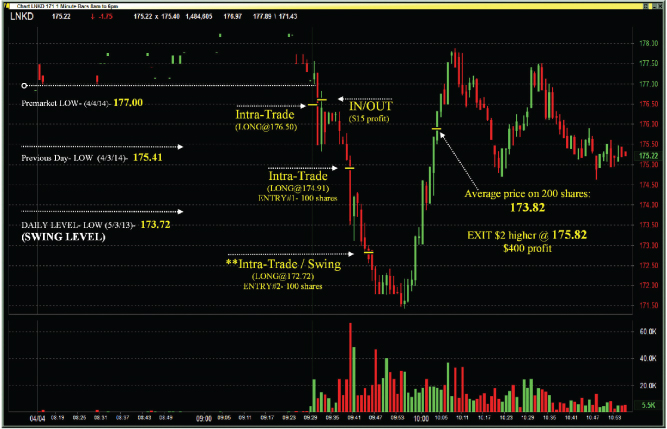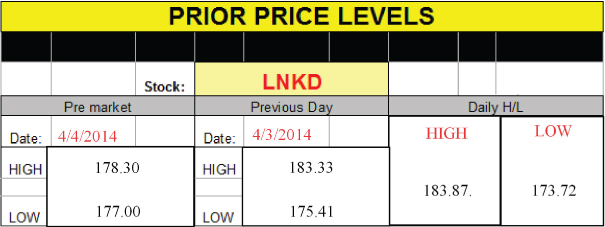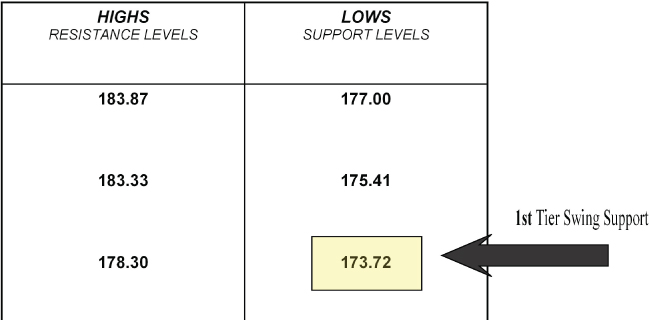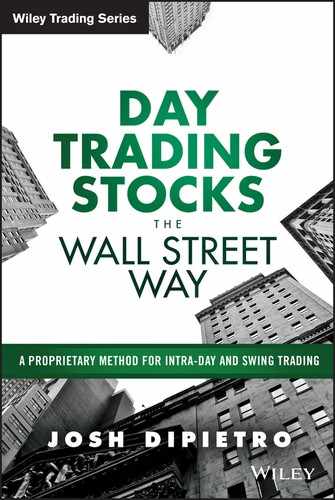Chapter 7
Introduction to Fusion Trading
The term Fusion Trading is my own. I like to use that term for quick reference. You'll see it here over and over, and my trainees hear me say it all the time. But you won't find it listed on Wikipedia—not yet. And for now, you won't hear the word fusion on Wall Street unless you bump into one of my graduates.
Though the term is my invention, the system itself is not. Fusion is creatively implemented by most professional day traders, especially the countertrend traders. As a whole, fusion methodology gives trading on Wall Street the legendary calibre it's known for. The more you get acquainted with this system, the more you're going to realize that the same key price levels that I trade are traded in high volume on Wall Street. Now that you've seen both my intra-day and swing trading frameworks, this part of the text will make perfect sense to you (about as much sense as a map makes without your having been on the road).
Before I get straight to the core of fusion trading, I want to point out a couple of facts. Most novices call themselves either “intra-day” or “swing” traders without a full understanding of how each distinct strategy works. Some jump right to swing trading (ouch!), and some never advance from intra-day trading to mastery of the swing setups.
As I've mentioned many times previously, fusion is the synergy of both, and you're going to find that my use of both strategies for every trade setup (yes, I said every trade setup) is totally logical. The reason is that intra-day and swing methods are not mutually exclusive.
Why Are They Not Mutually Exclusive?
Most beginners try to learn day trading alone, and advanced traders tend to be lone wolves who came up the hard way without much help, showcasing the scars from their disasters. The novices tend to be unaware that the full scope means using both systems, and even the much more experienced, who know something about orchestrating fusion, fail to achieve consistent profits.
No matter whether they're beginners or not, very few traders come to me knowing these critical facts:
- Intra-day trading must be learned prior to swing trading.
- Intra-day and swing trading are very much interlinked (Fusion Trading).
When I first started trading in 1998, nobody taught me those two facts. With regard to the first fact, I hadn't been properly coached. The professional trading seminars and workshops I attended never taught me that truth. I did learn how to read charts, both the intra-day and the dailies. I got a good sense of what an intra-day price level is, and what is a stronger swing level. But I was never taught how to differentiate them, or to start first with intra-day setups.
As a result, I would mistakenly trade an intra-day support/resistances level. And then, if my trade was in the red at market close, I would always hold overnight. I thought that was okay.
That was a classic mistake! I wasn't fully cognizant that the intra-day levels I traded were not strong enough to hold past that day. Now I know different, and I emphatically teach it. Not only is that type of overnight hold as risky as hanging off a cliff by your thumb, it doesn't even make sense to do it. Think about it. Why would you do this with a weak intra-day level when you're only supposed to be profiting 15 cents on it?
But many novice traders simply hold overnight and pray that the stock price goes in their favor by the next market opening. Does the “slippery slope” image come to mind here? It should.
There are logical reasons why the mastery of intra-day first makes perfect sense. Most importantly, when you start to learn trading, it's imperative that you remain in a low-risk exposure environment. Only the intra-day setups provide that safety net. If you've been instructed to minimize risk, then you know to not hold overnight, and you're looking for quick exits. On the contrary, swing trades are held for much longer and usually with more shares. So putting off the learning of swing trades and starting with intra-day setups is a great way to get to know your stock without losing your shirt in the process.
Parts 1 through 3 made you very aware that whether you're intra-day or swing trading, you need to know your pre-market data, and you need to know how to read a one-minute candlestick chart (just to name a couple of essentials). You also learned that mastery of intra-day trading is prerequisite to your swing setups.
The ultimate reason to start with intra-day trading is all about what I call the rhythm factor. I've alluded to this before. This is about profoundly reading your stock, just as you do with every nuance of your all-time-favorite song, just as profoundly as you read your life partner. The rhythm factor is working when you know your stocks inside and out, and you master this feat only with an intra-day trading foundation.
Even I, the founder of this system, cannot start swing trading a new stock without watching and getting in rhythm with it on an intra-day basis first. This process can take weeks and even months. I want to know how my new stock trades in pre-market. I want to know how it trades when it's breaking daily price levels (for both intra-day and swing setups). I'm all over it: intra-day price movements, the speed, the average H/L range per day, and so on.
I need to get in rhythm with my new stocks because eventually I'm going to marry them. I can't be that guy who's planning his wedding while he's driving to his blind date! Back when I was a novice, every time I didn't commit to learning a stock's total rhythm, things ended very ugly. I learned the hard way.
Here you can learn from my mistakes. I've mapped out a golden path. Just stay on the path; don't meander. Stick with the sequence of intra-day first, and then get into swing, and then the fusion of both.
“What?” I can picture you yelling. I just taught you to start with intra-day first. So what's that conundrum about?
It's critical to learn the entire system prior to trading live with real money. I'm not saying you can't intra-day trade exclusively. Sure you can. But either way, you need to know where your swing levels are prior to entering an intra-day setup.
Here's an example of why you need to know both at once. Suppose you wanted to enter an intra-day trade without knowing where your next swing tier was at. You could be as much as $10+ off your mark. This is why, in Part 2, I had you practice the Golden Rules. Remember the rule that commands you to only enter an intra-day trade if it's within $3 of a daily price level? You're going to find in this part of the book that those daily levels can become swing levels.
Consider this. If you were to find strong swing levels, but you failed to account for newly formed intra-day levels, such as pre-market intra-day levels, then your swing entry would be off the mark on virtually every trade. Any system that shows you strong swing levels and has you place static entries the next day without accounting for newly formed intra-day levels is a system that's going to fail.
Let's take a look at the system in action. I'll begin with the basics and show a sample trade setup to help you understand visually how this works.
Your goal in fusing both strategies is to plan your intra-day trades in conjunction with your swing setups. That's precisely why you must know your swing levels prior to entering any intra-day setup, and vice-versa. Using my Golden Rules, you must know your intra-day setups in order to trade into a swing. Yes, you'll learn intra-day trading first, but ultimately in every trade with this system you're going to initially define the trade by the swing levels/tiers.
Figure 7.1 shows a classic fusion trade setup using LNKD.

Figure 7.1 Classic Fusion Trade Setup
Suppose you had a first-tier swing long level at 173.72. You would wait to start intra-day trading until the intra-day support price levels formed in the range of $176.00–$177.00 (within $3 of your first-tier swing level). Once you entered the first intra-day trade, and if the price ran against you, then you could enter again off your swing level.
Below I address three primary guidelines and procedures that clarify how you capture all these levels on Figure 7.1. It boils down to these key intra-day and swing trade setup-preparations:
- You need to know where your first-tier swing level is.
- You need to be armed with your prior price levels on your whiteboard by 9:30 a.m., with the numbers in numerical order.
- You apply the Golden Rules once the bell rings.
The charts in Figures 7.2 and 7.3 show the prior price levels that were gathered on LNKD during pre-market on April 4, 2014.

Figure 7.2 Prior Price Levels—LNKD

Figure 7.3 First-Tier Swing Support Level
Applying the Golden Rules
To keep things basic for now, I've simply shown you the first-tier swing support level, which is 173.72. If you were to back-test, you'd find that, according to the swing rules and procedures in Part 3, at that time it was in fact a first-tier swing level.
For your convenience, in Figure 7.2, I've listed all the prior levels that pertain to the trade setup in Figure 7.1. I also created the whiteboard chart in Figure 7.3, which takes all the numbers from Figure 7.2 and puts them in numerical order.
As you know from your previous reading, the final step in the process is applying the Golden Rules. You can enter your first trade after the bell rings, if the Rules indicate you should. The Rules are so important that I'm displaying them again here in a feature box for reference.
Referring back to Figure 7.1, I will narrate a description of the entire illustrated setup.
It's almost 9:30 a.m. The bell is about to ring. I'm prepared to fusion-trade LNKD because I've found that it's been trading within $3 of the 173.72 first-tier swing price level. I've gathered all my prior price levels and I have them in front of me, looming large across the whiteboard on my wall. I'm locked and loaded and ready to execute a trade—but only if the price drops.
“Why?” you might ask. “You can only intra-day trade if the price drops?”
Yes. Think about it. If your first tier is a support level, then the price must drop to hit it. Therefore, you're only monitoring your support price levels (the right-column numbers in Figure 7.2). In this example the price does drop, so I'll be trading the right-column support levels on the way down.
“What if it shot up instead?” Then there simply would be no trade. I'd trade other stocks that day. But chances are whenever I get to within $3 of a swing level, the price does continue in that direction, just as it's doing today.
So here we go! Ding-ding-ding! The market is open and the price is plummeting. I have a plan and my price levels to enter at, so execution of the order entry is all I need to do. I apply the Golden Rules for intra-day trading and confirm that the 177.00 support level can be traded as my first entry. Also according to the Rules, 177.00 can be traded because the second entry of 175.41 is within $3 of it, plus my swing level is within $3 of the 177.00 level.
Now all I have to do is wait for the 177.00 price level to break the initial time, and then enter the trade at exactly 50 cents past. Once the price hits 177.00, I enter using fastkey order execution to buy/long at 176.50. The order fills very quickly, within minutes after the bell.
What about my exit strategy? What profit do I take, 15 cents or $2.00? I can choose either option. In this example I take the standard 15-cent profit on this intra-day setup. The price pulls back one minute later for my 15-cent profit ($15 profit with 100 shares). The trade for 177.00 is over, and now I'm back on the sidelines looking to reenter a new trade at lower price levels.
My next intra-day support price level is 175.41. Can I trade this price level? Yes, it, too, is within $3 of my next entry, because it happens to be the swing price level of 173.72.
About six minutes after my last trade exit, the price continues to drop. At this point, I'm simply waiting for the 175.41 support price level to hit. As soon as it does, I'll execute a buy/long limit order for 174.91(50 cents past 175.41).
But this particular intra-day trade doesn't pull back for a 15-cent profit. It continues to drop instead, and it's heading right for my swing price of 173.72. So I make the decision to delete my 15-cent profit target order on the 174.91 entry (intra-day trade), and I prepare to enter my second entry on this new trade setup. But this time the second entry will be a swing entry, so I can hold the entire trade (200 shares) for a full $2 profit.
This trade is about to become a fusion trade. It hits the 173.72 swing price level, so I execute another 100-share order at $1.00 past 173.72. A couple of minutes later, the price hits 172.72. I now have 200 shares with an average price of 173.82. I execute a sell order for 200 shares at a $2.00 profit. My exit price target is 175.82. That price hits 15 minutes later and I exit the fusion trade with a $400 profit.
Keep in mind that this example reversed on the first-tier swing before the market closed. In many cases the price will run much lower all day, and that's fine, because you'll always have lower swing tiers to enter at. Don't assume the trade will immediately reverse back to the green on the same day, as it does in this example. That's a very common amateur mistake.
Whenever you're countertrend trading, being in the red is perfectly normal. If you execute your swing levels properly, then you'll always land square in the green.
You might ask: “What if the price never reverses before the market close?”
That's a great question. For now, I'll give the most basic answer. In the example I've shown here, I had 200 shares. One of the trades was a swing trade and the other was an intra-day trade. The first 100-share entry of 174.91 was from an intra-day level. So, if the price didn't hit my $2 profit target on the fusion trade before the close (the 50% profit rule applies here as well), I would have had to sell/close 100 shares at 3:59 p.m. It didn't matter whether that 100 shares was a loss or a profit. You know that I couldn't hold an intra-day position overnight.
I would regain the small loss over the next day, or days, when I would sell my swing position at a $200+ profit. I say $200 plus because I could accumulate more swing levels and place more intra-day trades while still in the current swing, thus more potential profits. Also, the price could have gapped up overnight more than $2.
In Part 5, Chapter 9, I introduce what I call pivot trading and other advanced strategies. They show you how to recoup losses from intra-day setups that were closed out in the red, before the market closed. For now, just focus on the concept of fusion. You can turn your intra-day setups into a swing and ride them for the full $2 profit. That's all you need to understand at this point.
Deciding Your Trading Options: Intra-Day Only, Swing Only, or Fusion?
I never use intra-day trading exclusively for 15-cent profits—not anymore.
“Why not?” you might ask. There are a few reasons. The biggest reason is obvious. I would much rather make $2.00 per trade than 15 cents. So would you.
A second reason is I've become a master swing trader. Every trade I make is built around strong swing levels, whether I'm exclusively waiting for a swing level to hit, or I'm fusion trading. Either way, on every trade I'm going to make my profit target of $2. At this point in my trading career, I have no incentive to work hard for intra-day setups, because they net so much less reward. For instance, if my intra-day setup runs deep into the red and the market is about to close, I have no choice but to stop-loss. From time to time this happens to everyone: most of those small profits get wiped out on bad days when the price runs deep into red.
(But as you know, I always use intra-day setups to help determine my swing setups. I'm not looking for intra-day 15-cent profits, but at all times I do watch the intra-day levels while I'm swing and fusion trading.)
Of course you want to learn how to swing trade, for all of the reasons I do, with the goal of exclusively swing trading and/or fusion trading in the future. But you have to start somewhere, and intra-day trading is the place. I dedicate the first two or three weeks of my training program to intra-day trading only, all on a demo trading platform. That way no one loses money, but everyone learns the intra-day system prior to the swing trading system, and at zero monetary risk.
With that said, I now address those who are itching to finish this book and jump right into swing trading without mastering intra-day first.
So start with intra-day setups and be happy with 15 cents on your trades while practicing on a demo. If you don't, you're going to lose money. Every single trainee who enters my coaching program starts with intra-day trading, and only on harmless demos. After you've mastered the intra-day setups and are in rhythm with your stock(s), then it's time to start the swing trading. Once you master the swing, then you can work on the fusion. You build your skill set to the pinnacle.
Your comfort zone should totally jive with how well you know this system. So should your capital/buying power. For instance, if you have limited capital, you may only want to swing trade, and only trade the strongest swing tiers within the 5 percent bubble (see Part 3). On the other hand, if you're highly capitalized and have mastered both intra-day and swing setups, then you can go right into fusion, and with more than 100 shares per entry.
The sky is the limit when you trade with this system. But I can't possibly know how to coach you without knowing you and your skill set. In this book I can only offer options and leave it to you to decide what works best.
In Chapter 8, I offer several examples of swing setups and fusion setups.
